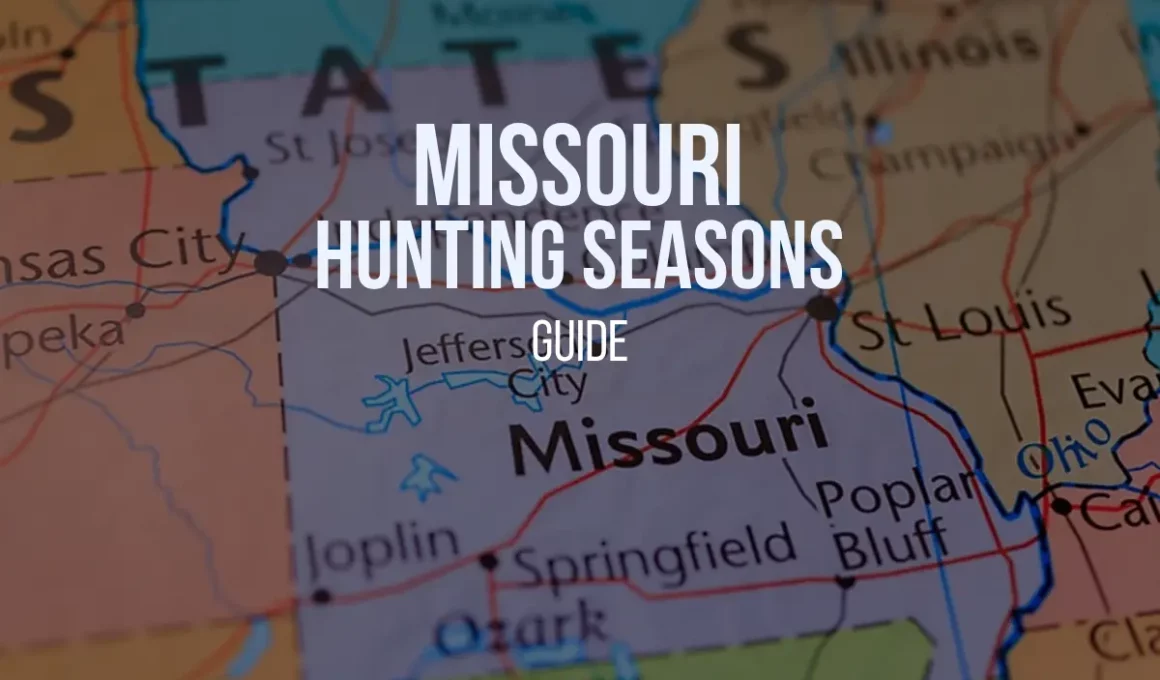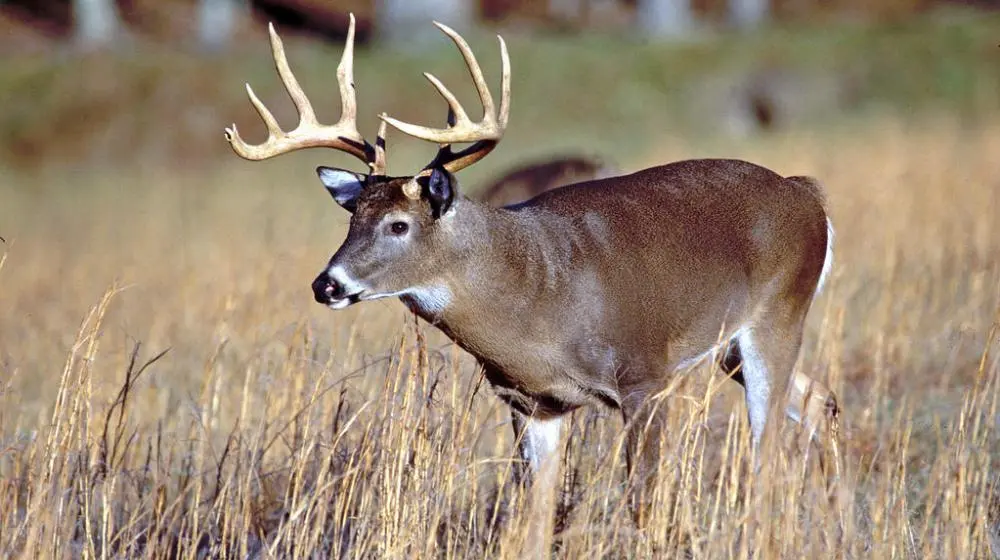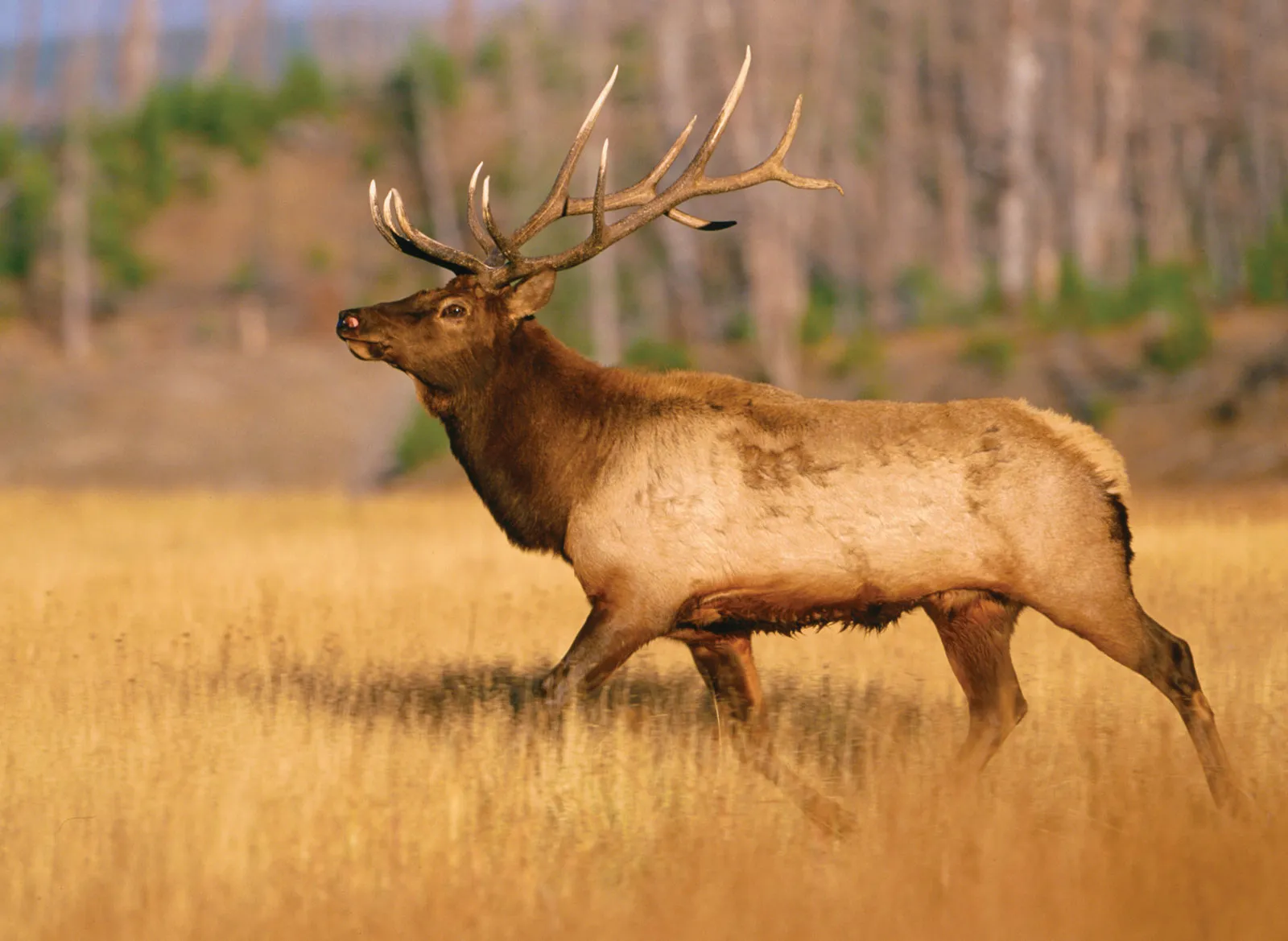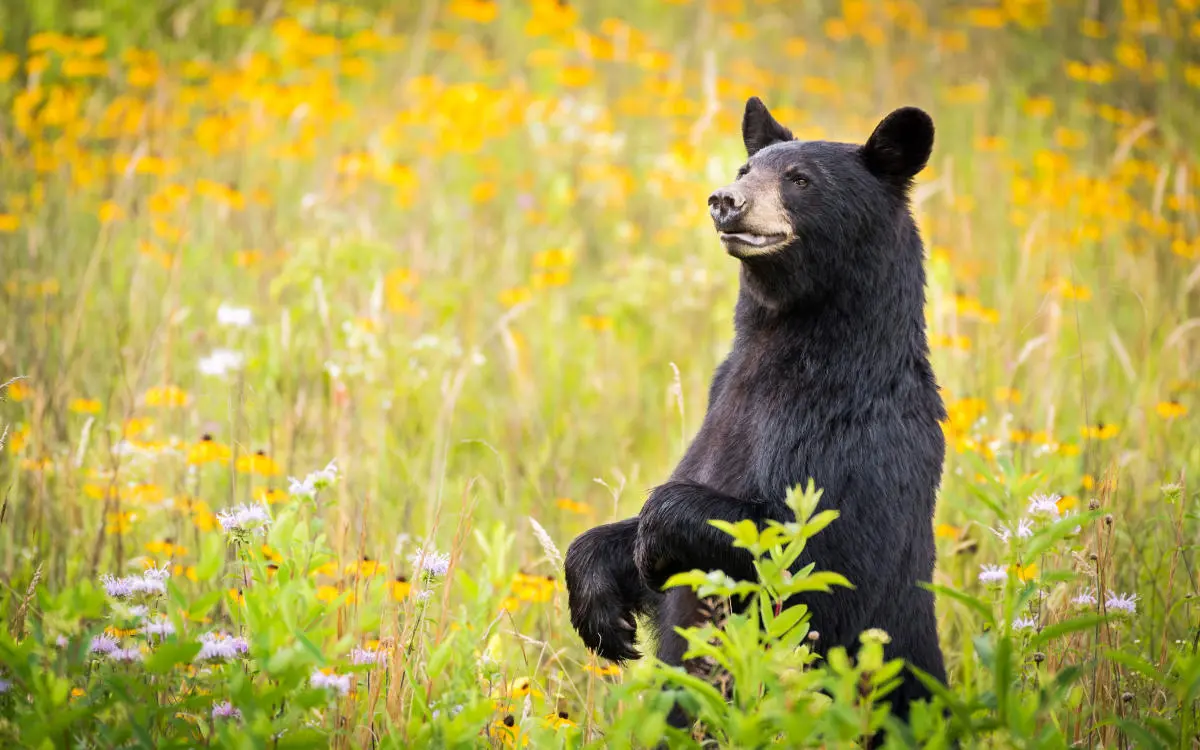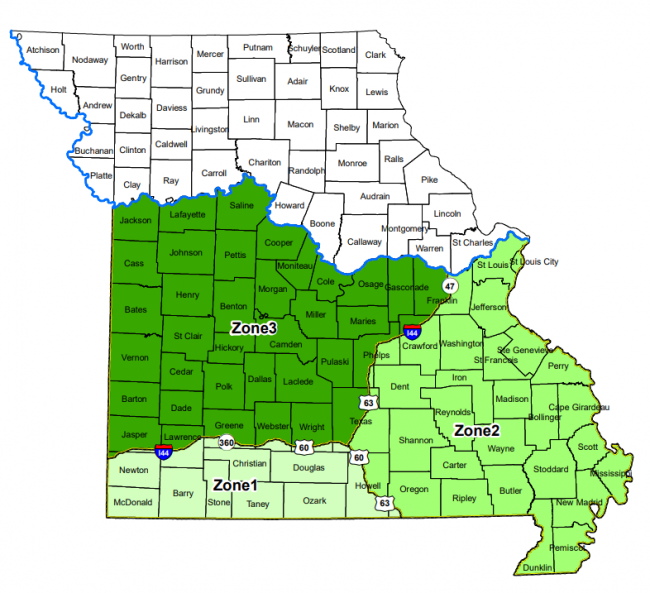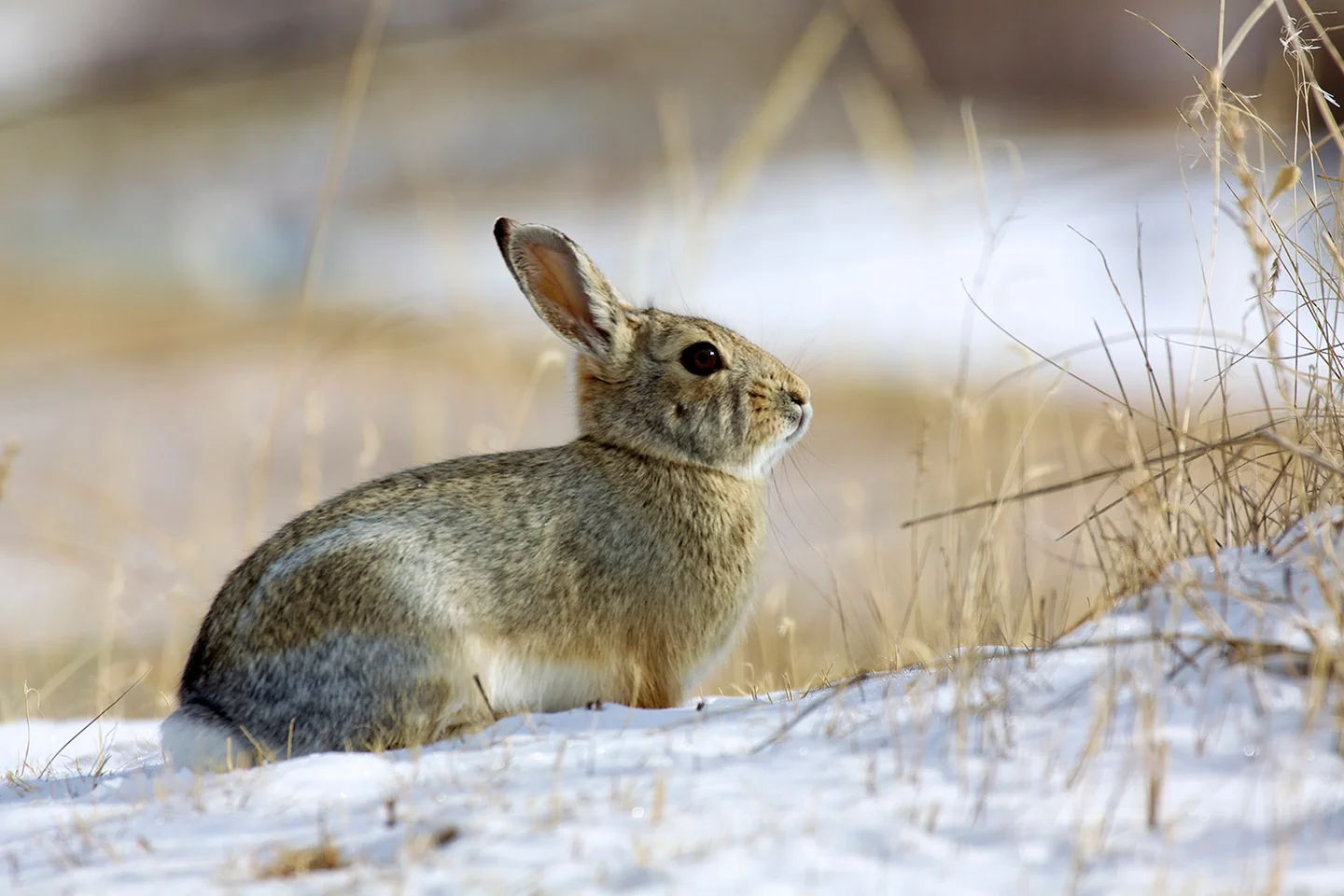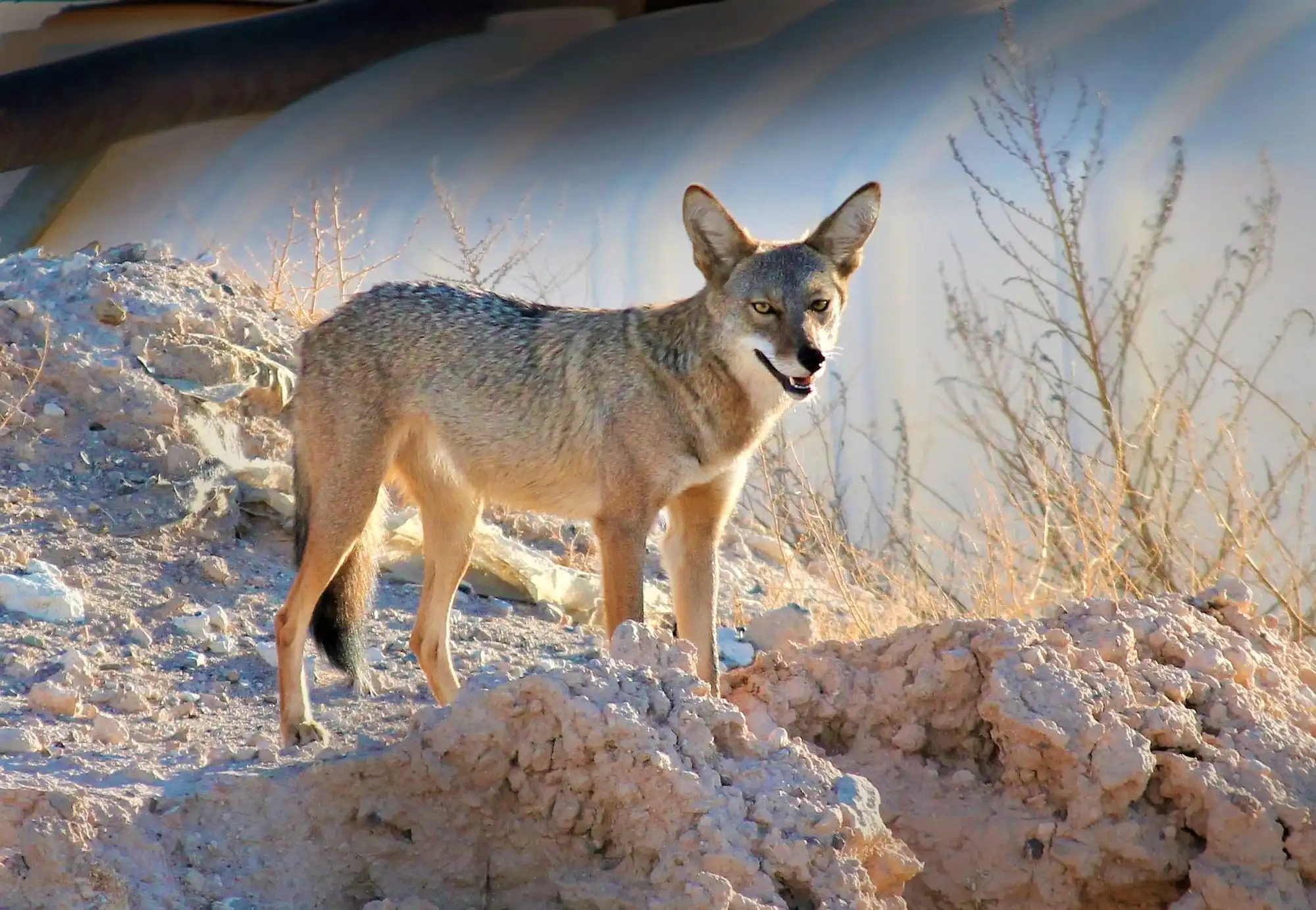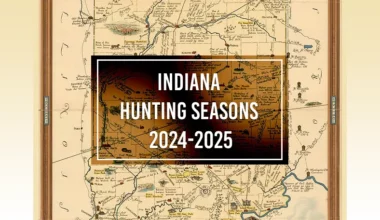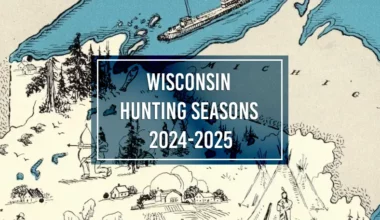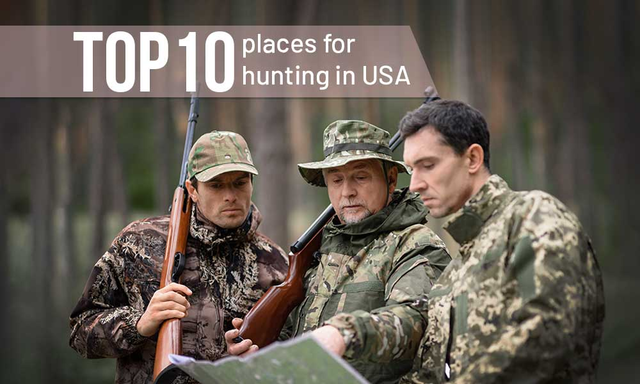Missouri’s hunting scene is a rich tapestry of tradition, diversity, and accessibility that stands out in the American Midwest. MO, particularly with the northern regions, offers some of the best deer hunting opportunities in the country despite recent challenges with CWD. However, the resilience of Missouri’s wildlife management efforts is evident in the gradually increasing harvest rates. Moreover, the recent inclusion of seasons for elk and black bear hunting further showcases Missouri’s evolving hunting landscape. By the way, the hunting tags in the state, when compared to neighboring states, are quite affordable for both resident and non-resident hunters.
Beyond deer, the state is a haven for waterfowl hunters, taking advantage of the Mississippi Flyway’s major migration routes, and offering vast wetlands for an ideal hunting setting. Also, Missouri boasts great turkey hunting, thanks to one of the largest wild turkey populations in the U.S., making it a prime spot each spring and fall.
Small game hunting is another draw here, supported by extensive forested areas ideal for rabbit and squirrel hunting.
Hunting Seasons in Missouri by Game Species
Missouri Deer Hunting Season
Deer Archery Seasons:
Early: September 15, 2024 to November 15, 2024
Late: November 27, 2024 to January 15, 2025
Antler-point restrictions applied in certain counties.
Legal hunting hours: ½ hour before sunrise – ½ hour after sunset
Bag limits:
- Archer’s Permit allows 2 deer of either sex; only 1 antlered deer may be taken before the November firearms season.
- Unlimited archery antlerless permits, except in Dunklin, Mississippi, New Madrid, and Pemiscot counties.
- You may take a total of 2 antlered deer across archery and firearms seasons combined.
Valid Permits:
Archer’s Hunting Permit
Archery Antlerless Deer Hunting Permit
Deer Firearms Season (Antlerless Portions):
Early: October 11, 2024 to October 13, 2024
Late: December 7, 2024 to December 15, 2024
Some counties are closed to firearms hunting during these portions. See map.
Legal hunting hours: ½ hour before sunrise – ½ hour after sunset
Bag limits:
- Only antlerless deer can be hunted.
- County-specific antlerless deer permit limits apply during the entire firearms season (all portions). See map.
Valid Permits:
Resident Antlerless Deer Hunting Permit
Resident Firearms Any-Deer Permit
Deer Firearms Season (Youth Portions):
Early: November 2, 2024 to November 3, 2024
Late: November 29, 2024 to December 1, 2024
To participate, you must be between 6 and 15 years old on the early youth portion’s opening day. Hunters 15 or younger as of Sept. 15 are exempt from antler-point restrictions during the archery deer season and all firearms deer seasons.
Legal hunting hours: ½ hour before sunrise – ½ hour after sunset
Bag limits:
- During the early youth portion, only 1 deer (either sex) can be taken. Use extra permits in other portions.
- You can only take 1 antlered deer in the entire firearms season (all portions combined) and a total of 2 antlered deer across archery and firearms seasons combined.
- County-specific antlerless deer permit limits apply during the entire firearms season (all portions). See map.
Valid Permits:
Resident Firearms Any-Deer Permit
Resident Antlerless Deer Hunting Permit
Deer Firearms Season (November Portion):
November 16, 2024 – November 26, 2024
If you harvest a deer in the specified counties of the CWD Management Zone on Nov. 16-17, you must bring it to a CWD sampling station.
Legal hunting hours: ½ hour before sunrise – ½ hour after sunset
Bag limits:
- You can only take 1 antlered deer in the entire firearms season (all portions combined) and a total of 2 antlered deer across archery and firearms seasons combined.
- County-specific antlerless deer permit limits apply during the entire firearms season (all portions). See map.
Valid Permits:
Resident Firearms Any-Deer Permit
Resident Antlerless Deer Hunting Permit
Youth aged 6-15, whether residents or nonresidents, can buy a half-priced permit.
Deer Firearms Season (CWD Portion):
November 27, 2024 to December 1, 2024
Firearms hunting is only allowed in select counties during the CWD portion. See map.
Legal hunting hours: ½ hour before sunrise – ½ hour after sunset
Bag limits:
- You can only take 1 antlered deer in the entire firearms season (all portions combined) and a total of 2 antlered deer across archery and firearms seasons combined.
- County-specific antlerless deer permit limits apply during the entire firearms season (all portions). See map.
Valid Permits:
Resident Firearms Any-Deer Permit
Resident Antlerless Deer Hunting Permit
Youth aged 6-15, whether residents or nonresidents, can buy a half-priced permit.
Deer Alternative Methods Season:
December 28, 2024 to January 7, 2025
Antler-point restrictions applied in certain counties.
Legal hunting hours: ½ hour before sunrise – ½ hour after sunset
Bag limits:
- You can only take 1 antlered deer in the entire firearms season (all portions combined) and a total of 2 antlered deer across archery and firearms seasons combined.
- County-specific antlerless deer permit limits apply during the entire firearms season (all portions). See map.
Valid Permits:
Resident Firearms Any-Deer Permit
Resident Antlerless Deer Hunting Permit
Deer Hunting Methods, Arms, & Ammo
ARCHERY SEASON:
Allowed:
- Longbows, compound bows, and recurve bows (any draw weight)
- Crossbows
- Hand-held string-releasing devices
- Illuminated sights, scopes, and quickpoint sights
- Atlatls
Prohibited:
- Sighting devices that cast a beam of light on the game
- Possession of night vision or thermal imagery equipment with a hunting implement
- Electronic/electronically activated calls, bait, dogs, or night vision equipment
- Motor driven conveyances for hunting; motorboats off and stationary for other wildlife
- Archers cannot possess firearms during archery season (exceptions in Wildlife Code of Missouri – See 3 CSR 10-7.432 and 3 CSR 10-7.455)
FIREARMS SEASON:
Allowed:
- Centerfire pistols, revolvers, or rifles with expanding-type bullets (lead, copper, etc.).
- Shotguns (.410 included) using slugs.
- Air-powered firearms, .40 caliber or larger, charged externally.
- Muzzleloading or cap-and-ball firearms, .40 caliber or larger, single projectile discharge; in-lines and scopes permitted.
- Multiple-barreled muzzleloading handguns/revolvers, .40 caliber or larger.
- Longbows, compound bows, and recurve bows; enhancements like illuminated sights allowed.
- Crossbows.
- Atlatls.
Prohibited:
- Self-loading firearms holding more than 11 cartridges.
- Ammunition that propels multiple projectiles per discharge (e.g., buckshot).
- Full hard metal case projectiles.
- Fully automatic firearms.
- Sighting devices casting light on the game.
- Electronic/electronically activated calls.
- Night vision equipment.
- Bait use.
- Dog use.
- Local ordinances may apply additional restrictions.
- Motor vehicles, including boats with motors, cannot be used to hunt or disturb wildlife.
ALTERNATIVE METHODS SEASON:
Allowed:
- Muzzleloading or cap-and-ball firearms, .40 caliber or larger, firing a single projectile per discharge; in-lines and scopes permitted.
- Multiple-barreled muzzleloaders or handguns, .40 caliber or larger, including revolvers, allowed alongside a rifle.
- Centerfire pistols or revolvers with expanding-type bullets, like lead or copper.
- Air guns, .40 caliber or larger, using an external high compression power source (hand pump, air tank, or compressor).
- Longbows, compound bows, and recurve bows of any draw weight; hand-held string releases, illuminated sights, scopes, and quickpoint sights permitted.
- Crossbows.
- Atlatls, rods or narrow boards for launching darts 5 to 8 feet long through arm throwing motion.
Prohibited:
- Rifles loaded by any means other than the muzzle.
- Shotguns.
- Self-loading firearms holding more than 11 rounds total.
- Ammo propelling more than one projectile per discharge (e.g., buckshot).
- Hard metal case bullets.
- Fully automatic firearms.
- Sighting devices casting a light beam on the game.
- Electronic/electronically activated calls.
- Night vision gear.
- Baiting.
- Hunting with dogs.
- Using motorized vehicles for hunting, driving, or disturbing wildlife. Hunting from boats with motors is prohibited.
- Additional restrictions may apply per local laws.
Deer Hunting Permit Fees
Resident Firearms Any-Deer Hunting Permit:
- Resident – $18.00
- Resident landowner – $0.00
- Youth (5-16) – $9.00
- Nonresident – $276.50
- Nonresident landowner – $203.50
Firearms Antlerless Deer Hunting Permit:
- Resident – $7.50
- Resident landowner – $0.00
- Youth age 5-16 – $3.75
- Nonresident – $26.00
Archer’s Hunting Permit:
- Resident – $20.50
- Resident landowner – $0.00
- Youth (6-15) – $10.25
- Nonresident – $276.50
- Nonresident landowner – $203.50
Archery Antlerless Deer Hunting Permit:
- Resident – $7.50
- Resident landowner – $0.00
- Youth age 5-16 – $3.75
- Nonresident – $26.00
Deer Tagging & Telecheck:
Telecheck Process & Requirements:
- It’s required to Telecheck deer by 10 p.m. on the day of harvest.
- Those hunting in CWD Management Zone must Telecheck their deer before leaving the county.
- Use the MO Hunting app for a digital Telecheck and confirmation.
- Paper permit holders should find their Telecheck ID, call 800-314-6828 or visit mdc.mo.gov, and provide all the required information. Then, you are given a confirmation number that you need to write on your permit.
- After completing checking your game, you can start processing it.
Tagging and Notching:
- Tagging is not required if you stay with your harvested game. If leaving it, ensure the deer is tagged.
- For paper permits, attach the notched permit to the deer’s leg. Use of a zip-top bag for permit protection is recommended.
- MO Hunting app users should attach a label with name, address, permit number, and date of harvest to the deer’s leg.
- Notching should be done immediately post-harvest using either the MO Hunting app or by physically notching the paper permit.
- Once you notch your permit, you may transport your deer within Missouri.
Deer Hunting Regulations:
- Hunter orange is mandatory during firearms deer season.
- Check for legal baiting practices.
- Adults accompanying youth during firearms deer season do not need a hunting permit if they are either hunter-education certified or born before Jan. 1, 1967.
- Outside youth seasons, mentors need a valid permit or must be exempt.
- Tree stands placed on Conservation Department Areas are allowed from Sept. 1 to Jan. 31, with mandatory removal by Feb. 1. Stands must be labeled with the hunter’s full name, address, or Conservation number, avoiding damage to trees.
- Missouri Outdoor Recreational Access Program (MRAP)
- Hunters must follow specific rules on areas enrolled in the Missouri Outdoor Recreational Access Program (MRAP), such as removing tree stands daily.
- Hunters are required to make a reasonable effort to retrieve wounded or killed deer as part of their season limit. This doesn’t authorize trespass.Dogs can be used for game recovery without permitting trespass.
- Abandoning edible game parts is illegal. It’s illegal to dispose of deer carcasses or parts in any body of water.
Missouri Turkey Hunting Season
Turkey Youth Spring Season:
April 6-7, 2024
Only youth hunters who are age 6-15 on opening day may hunt. Youth may also hunt during the regular Spring Turkey season.
Legal hunting hours: ½ hour before sunrise – ½ hour after sunset
Bag limits:
- 1 male turkey or turkey with a visible beard.
- Youths taking a turkey in this season can’t take a second until the second Monday of the regular season, as the youth season turkey counts as their first bird for the first week of the regular season.
Valid Permits:
Turkey Spring Season:
April 15, 2024 to May 5, 2024
Legal hunting hours:
- ½ hour before sunrise to 1 p.m. on public land
- ½ hour before sunrise to sunset on private land.
Bag limit:
- 2 male or bearded turkeys. But:
- First week: Only 1 turkey can be taken.
- Second and third weeks: 2 turkeys allowed if none taken in the first week.
- Cannot take 2 turkeys on the same day.
Valid Permits:
Turkey Fall Archery Season:
Early: September 15, 2024 to November 15, 2024
Late: November 27, 2024 to January 15, 2025
Legal hunting hours: ½ hour before sunrise – ½ hour after sunset
Bag limit:
2 turkeys of either sex, both may be taken on the same day
Valid Permits:
Turkey Fall Firearms Season:
Statewide: October 1, 2024 to October 31, 2024
Dunklin, McDonald, Mississippi, New Madrid, Newton, Pemiscot, and Scott counties: Closed
Legal hunting hours: ½ hour before sunrise – sunset
Bag limit:
2 turkeys of either sex, both may be taken on the same day
Valid Permits:
Turkey Hunting Methods, Arms, & Ammo:
SPRING SEASON
Allowed:
- Shotguns (shot not larger than No. 4).
- Longbows, recurve bows, compound bows; hand-held string releasing devices, illuminated sights, scopes, quick point sights.
- Crossbows.
- Atlatls.
Prohibited:
- Shotguns holding more than 3 shells (magazine+chamber).
- Use or possession of shot larger than No. 4.
- Sighting devices casting a beam of light on game.
- Use or possession of thermal/night vision equipment.
- Recorded calls.
- Use of dogs or live decoys.
- Bait use; area considered baited for 10 days after bait removal. Hunters are in violation if hunting in a baited area, knowingly or not. It’s illegal to bait in a way that causes violation for others.
FALL ARCHERY
Allowed:
- Longbows, compound bows, recurve bows (any draw weight).
- Crossbows.
- Hand-held string-releasing devices.
- Illuminated sights, scopes, quickpoint sights.
- Atlatls.
Prohibited:
- Sighting devices that cast a beam of light on the game.
- Electronic calls, electronically activated calls, bait, dogs, night vision equipment.
- Live decoys.
- Possession of a firearm during archery season, with specific exceptions (refer to Wildlife Code of Missouri 3 CSR 10-7.432 and 3 CSR 10-7.455).
FALL FIREARMS
Allowed:
- Shotguns (incl. .410) with shot size up to No. 4.
- Longbows, compound bows, recurve bows (any draw weight).
- Crossbows.
- Atlatls.
- Hand-held string-release devices.
- Illuminated sights, scopes, quickpoint sights.
Prohibited:
- Shotguns holding more than 3 shells.
- Shot larger than No. 4.
- Rifles, pistols, single-projectile firearms.
- Sighting devices casting beams of light.
- Night vision/thermal imagery equipment.
- Electronic calls, live decoys, bait, dogs.
- Possession of both a firearm and a bow during the season, with specific exceptions (refer to 3 CSR 10-7.455 of the Wildlife Code of Missouri).
Turkey Hunting Permit Fees:
Spring Turkey Hunting Permit:
- Resident – $18.00
- Resident landowner – $0.00
- Youth (5-16) – $9.00
- Nonresident – $233.50
- Nonresident landowner – $172.00
Archer’s Hunting Permit:
- Resident – $20.50
- Resident landowner – $0.00
- Youth (6-15) – $10.25
- Nonresident – $276.50
- Nonresident landowner – $203.50
Fall Firearms Turkey Hunting Permit:
- Resident – $14.00
- Resident landowner – $0.00
- Youth (6-15) – $7.00
- Nonresident – $135.50
- Nonresident landowner – $100.00
Turkey Tagging & Telecheck:
Telecheck Process & Requirements:
- It’s required to Telecheck turkey by 10 p.m. on the day of harvest.
- Use the MO Hunting app for a digital Telecheck and confirmation.
- Paper permit holders should find their Telecheck ID, call 800-314-6828 or visit mdc.mo.gov, and provide all the required information. Then, you are given a confirmation number that you need to write on your permit.
- After completing checking your turkey, you can start processing it.
How to Telecheck Turkey:
Fall Turkey:
- Hunters are required to report the age and sex of their turkey.
- This data contributes to monitoring fall harvest trends.
- Optional submission of feathers for ongoing research projects.
Spring Season:
- Hunters must report the age, beard length, and spur length of their turkey.
- Spur length helps in assessing the age distribution within the turkey population.
Tagging and Notching:
- Tagging is not required if you stay with your harvested turkey. If leaving it, ensure the turkey is tagged.
- For paper permits, attach the notched permit to the turkey’s leg. Use of a zip-top bag for permit protection is recommended.
- MO Hunting app users should attach a label with name, address, permit number, and date of harvest to the turkey’s leg.
- Notching should be done immediately post-harvest using either the MO Hunting app or by physically notching the paper permit.
- Once you notch your permit, you may transport your turkey within Missouri.
Turkey Hunting Regulations:
- Mentors assisting youth hunters do not need a permit during the youth spring turkey season and youth portions of firearms deer season. At other times, mentors must have a valid hunting permit for the current season or be exempt; their permit may be either filled or unfilled.
- Baiting Regulations:
- Using bait, including grain or feed to attract turkeys, is illegal.
- Mineral blocks without grain or food additives aren’t considered bait.
- Hunting over a harvested crop field is allowed, but adding grain or crops to the field after it has been harvested is not.
- Crop manipulation, like mowing, isn’t seen as baiting for turkeys.
- After harvesting a turkey, hunters must immediately void their permit by marking the month and day of harvest.
Missouri Elk Hunting Season
Elk Archery Season:
October 19, 2024 to October 27, 2024
Antlered Elk Hunting permits can be used during both the archery and firearms portions of the season.
Legal hunting hours: ½ hour before sunrise – ½ hour after sunset
Bag limits:
- Selected permit holders may harvest 1 elk with at least 1 antler no less than 6″ in length.
Valid Permits:
Elk hunting permits are distributed by random drawing.
Antlered Elk Hunting Permit
Methods, Arms, & Ammo:
Allowed:
- Longbow, compound bow, recurve bow (any draw weight).
- Atlatls (5 to 8 feet long darts).
- Hand-held string releasing devices.
- Illuminated sights, scopes, quickpoint sights.
- Crossbow.
Prohibited:
- Sighting devices casting a beam of light.
- Electronic calls, bait, dogs, night vision equipment.
- Hunting elk from a motorized boat.
- Hunting elk in water.
- Hunting within enclosures over 7’ high.
- Possession of a firearm during archery season, with specific exceptions (refer to Wildlife Code of Missouri 3 CSR 10-7.705).
Elk Firearms Season:
December 14, 2024 to December 22, 2024
Antlered Elk Hunting permits can be used during both the archery and firearms portions of the season.
Legal hunting hours: ½ hour before sunrise – ½ hour after sunset
Bag limits:
- Selected permit holders may harvest 1 elk with at least 1 antler no less than 6″ in length.
Valid Permits:
Elk hunting permits are distributed by random drawing.
Antlered Elk Hunting Permit
Methods, Arms, & Ammo:
Allowed:
- Centerfire pistols, revolvers, rifles (expanding-type bullets).
- Shotguns (.410 included) with slugs.
- Air-powered guns, .40 caliber+, charged externally.
- Muzzleloading/cap-and-ball firearms, .40 caliber+, single projectile.
- Muzzleloading handguns/revolvers, .40 caliber+.
- Longbows, compound bows, recurve bows (any draw weight).
- Hand-held string-releasing devices, illuminated sights, scopes, quickpoint sights.
- Crossbows.
- Atlatls.
Prohibited:
- Self-loading firearms with >11 cartridge capacity.
- Ammunition propelling >1 projectile per discharge.
- Full hard metal case projectiles.
- Fully automatic firearms.
- Sighting devices casting beams of light.
- Electronic calls, bait, dogs, night vision equipment.
- Hunting elk from motorized boats.
- Hunting elk in water.
- Hunting in enclosures >7’ high.
- Local ordinances may apply additional prohibitions.
Elk Hunting Permit Fees:
- Resident – $50.00
- Resident landowner – $50.00
Elk Tagging & Telecheck:
Telecheck Process & Requirements:
- It’s required to Telecheck elk by 10 p.m. on the day of harvest.
- Use the MO Hunting app for a digital Telecheck and confirmation.
- Paper permit holders should find their Telecheck ID, call 800-314-6828 or visit mdc.mo.gov, and provide all the required information. Then, you are given a confirmation number that you need to write on your permit.
How to Telecheck Elk
- Elk must be checked via telephone or online; no physical stations for checking.
- Harvesters have until 10 p.m. on the day of harvest to check their elk.
- Before checking, elk can be field-dressed or quartered but must retain evidence of sex.
- Unchecked elk may be transported within Missouri if the permit is attached to the elk or with the hunter and the hunter is present with the elk.
- Information needed for checking includes:
- Type of elk (bull or cow)
- Number of antler points 1 inch or longer
- County of harvest
- Whether harvested on public or private land
Tagging and Notching:
- Tagging is not required if you stay with your harvested elk. If leaving it, ensure the elk is tagged.
- For paper permits, attach the notched permit to the elk’s leg. Use of a zip-top bag for permit protection is recommended.
- MO Hunting app users should attach a label with name, address, permit number, and date of harvest to the elk’s leg.
- Notching should be done immediately post-harvest using either the MO Hunting app or by physically notching the paper permit.
- Once you notch your permit, you may transport your elk within Missouri.
Elk Hunting Regulations:
- It’s required to use hunter orange during firearms elk hunting season. Consult the official hunter-orange requirements for detailed guidelines.
- Baiting Regulations
- Prohibited:
- Utilizing bait, including grains or feeds to attract elk, is illegal.
- An area remains considered baited for 10 days post bait removal.
- Hunters aware or should be aware of baited areas and attempting elk harvest in these areas are in violation.
- Placing bait that results in another’s violation is illegal.
- Mineral and salt blocks are banned on conservation areas.
- Allowed:
- Use of elk urine and scents (apple, acorn, persimmon) permissible if not combined with grains or food.
- Mineral blocks (excluding those with grain/food additives) and salt not classified as bait (still prohibited on conservation areas).
- Legal to hunt over harvested crop fields but illegal to add grain or other crops to the field after it has been harvested.
- Crop manipulation (mowing, knocking down) isn’t considered baiting.
- Open Counties
- Elk hunting is permitted only in Carter, Reynolds, and Shannon counties.
- Elk hunting is not allowed in the refuge portion of Peck Ranch Conservation Area.
- Assisting Other Elk Hunters
- Adults accompanying youth hunters (ages 11-15) do not need an elk hunting permit if they meet certain qualifications (age and education).
- To assist in taking elk during the season, including calling, an unfilled elk permit is required, except when simply accompanying without assisting.
- Tree Stands on Conservation Department Areas
- Use of portable tree stands is allowed between September 1 and January 31.
- Tree stands must be labeled with the hunter’s full name and address, or Conservation number. Damaging trees is illegal.
- All tree stands must be removed by February 1.
- Missouri Outdoor Recreational Access Program (MRAP) areas have special rules, including the requirement to remove tree stands daily. Hunters must familiarize themselves with and adhere to posted MRAP rules.Retrieval of Game
- You must make a reasonable effort to retrieve a killed or injured elk.
- It is illegal to leave or abandon commonly edible portions of game.
- It’s illegal to place any part of an elk carcass into aquatic environments.
- Use of Dogs for Hunting and Recovery
- Dogs cannot be used or brought along while hunting elk.
- Leashed dogs, under direct handler control, can be used to track and recover wounded elk.
- Trackers do not need hunting permits unless they wounded the elk.
- Trackers may not possess a firearm, bow, or crossbow, except for concealable firearms under specific conditions.
- Possession and Sale
- Properly checked elk can be possessed by anyone if labeled correctly.
- Elk left at processing or cold storage must be claimed by May 1 after the season.
- Elk parts (heads, antlers, hides, feet) can be sold with a proper bill of sale.
- Finders of dead elk with antlers attached must report the find within 24 hours for authorization.
- Shed antlers not attached to the skull plate do not require authorization for possession or sale.
Missouri Bear Hunting Season
Bear Hunting Season Dates
October 21, 2024 to October 30, 2024
Legal hunting hours: ½ hour before sunrise – ½ hour after sunset
Bag limits:
- 1 black bear of either sex.
- Restrictions:
- You must call 800-668-4045 daily to check quota/closure status. If harvest reaches/exceeds 80% of quota, the season may be closed by the director the following day.
- Once quota is met or director closes the season in your BMZ, you cannot harvest a black bear.
- Bears in dens cannot be harvested or harassed.
- Only lone bears can be harvested. Bears with cubs or in a group are off-limits.
Valid Permits:
Bear Hunting Methods, Arms, & Ammo
Allowed:
- Centerfire rifles/handguns (expanding-type bullets).
- Shotguns (slugs only).
- Air-powered guns (.40 caliber+, charged from an external high-compression power source).
- Muzzleloading/cap-and-ball firearms (.40 caliber+, single projectile). In-lines/scopes permitted.
- Multiple-barreled muzzleloading or cap-and-ball firearms and/or muzzleloading or cap-and-ball handguns, including revolvers (.40 caliber+), are allowed and may be carried in addition to a muzzleloading or cap-and-ball rifle.
- Longbows, compound bows, recurve bows. Hand-held string-releasing devices, illuminated sights, scopes, quickpoint sights.
- Crossbows.
Prohibited:
- Self-loading firearms (>11 cartridge capacity). Exceptions noted in Wildlife Code of Missouri 3 CSR 10-7.900.
- Multi-projectile ammunition (e.g., buckshot).
- Full hard metal case projectiles.
- Fully automatic firearms.
- Use of dogs.
- Baiting (food placed/scattered to attract bears). Note: scents and minerals, including salt, are not considered bait unless mixed with food additives. Salt and minerals are prohibited year-round within Chronic Wasting Disease Management Zone counties.
- Area considered baited for 10 days after bait removal; illegal to hunt with knowledge of baiting.
- Electronic/electronically activated calls.
- Artificial lights, night vision, thermal imagery, telemetry equipment.
- Hunting bears in water or from a motorized boat/vehicle or aircraft.
- Local ordinances may apply additional restrictions.
Bear Hunting Permit Fees:
- Resident – $25.00
Bear Tagging & Telecheck:
Telecheck Process & Requirements:
- It’s required to Telecheck bear by 10 p.m. on the day of harvest.
- Use the MO Hunting app for a digital Telecheck and confirmation.
- Paper permit holders should call the telephone number listed on the permit or visit mdc.mo.gov, and provide all the required information. Then, you are given a confirmation number that you need to write on your permit.
How to Telecheck Bear
- Bear must be checked via telephone or online; no physical stations for checking.
- Before checking, bear can be field-dressed or quartered but must retain evidence of sex.
- Unchecked bear may be transported within Missouri if the permit is attached to the bear or with the hunter and the hunter is present with the bear.
- Information needed for checking includes:
- Your Telecheck ID Number (found on your permit)
- The sex of the bear
- County of harvest
- Was it harvested on public or private land?
- Weapon used to harvest the bear
- Weight range (estimated in pounds)
- Does the bear have a collar?
- If the bear has ear tags, the color and number for left and right ear tags
Tagging and Notching:
- Tagging is not required if you stay with your harvested bear. If leaving it, ensure the bear is tagged.
- For paper permits, attach the notched permit to the bear’s leg. Use of a zip-top bag for permit protection is recommended.
- MO Hunting app users should attach a label with name, address, permit number, and date of harvest to the bear’s leg.
- Notching should be done immediately post-harvest using either the MO Hunting app or by physically notching the paper permit.
- Once you notch your permit, you may transport your bear within Missouri.
Black Bear Hunting Regulations:
- Black bear hunting is allowed south of the Missouri River in three Black Bear Management Zones (BMZs). You may hunt only in the BMZ specified on your permit.
- Assisting Other Hunters
- Adults with youth hunters (11–15) need no permit, must be 18+, and have hunter education or born before 01/01/1967.
- Outside this, a filled/unfilled Resident Permit is needed to assist in bear hunting.
- Accompanying without assisting in the hunt does not require a permit.
- Hunter-Orange Requirement: Mandatory for all hunters during the black bear season, including bow hunters.
- Use of Dogs: Dogs are prohibited while hunting black bears unless used for tracking wounded bears with strict conditions.
- Retrieval of Game: Hunters must attempt to retrieve and include killed or injured bears in their season limit without authorizing trespass.
- Wanton Waste: It is illegal to intentionally waste any part of the wildlife commonly consumed as human food.
- Tree Stands on Conservation Areas: Placement is permitted between Sept. 1 and Jan. 31, with specific labeling and removal requirements.
- Portable Blinds on Conservation Areas: Allowed with daily removal and specific labeling recommendations; hunter-orange must be displayed for visibility.
- Giving Away Game: Harvester can gift bear meat but must include their full name, address, date taken, and Telecheck confirmation number. Bear gall bladder cannot be given away. The bear counts toward the giver’s season limit.
- Possession, Storage, and Sale: Anyone can possess a checked bear with proper labeling including taker’s details and Telecheck confirmation number. Bears must be claimed from storage by May 1 after the season. Legally acquired wildlife parts can be sold with a bill of sale.
- Black Bear Gallbladders: Regardless of the state of harvest, black bear gallbladders may not be bought, sold, offered for sale, transferred, or given away. Extracted black bear gallbladders may not be transported into or within Missouri.
- Premolar Tooth Submission: Harvesters of black bears are required to submit a premolar tooth to the authorities within 10 days of the harvest.
Waterfowl & Migratory Bird Hunting Seasons in Missouri
Geese Hunting Season:
Greater White-Fronted Geese Season: November 11, 2024 to February 6, 2025
Daily limit: 2
Possession limit: 6
Light Geese Season: November 11, 2024 to February 6, 2025
Daily limit: 20
No possession limit.
Light Conservation Order: February 7, 2024 to April 30, 2024 and February 7, 2025 to April 30, 2025
Bag limit: None
Brant Geese Season: October 7, 2023 to October 15, 2023 and November 11, 2023 to February 6, 2024
Daily limit: 3
Possession limit: 9
Daily and possession limits are brant and Canada geese combined.
Ducks and Coots Hunting Season:
Teal: September 7, 2024 to September 22, 2024
Daily bag limit: 6
Possession limit: 18
Limits are a combined total of all teal species.
North Zone (Ducks & Coots): November 2, 2024 to December 31, 2024
Middle Zone (Ducks & Coots): October 7, 2023 to October 15, 2023 and November 11, 2023 to February 6, 2024
South Zone (Ducks & Coots): November 28, 2024 to December 1, 2024 and December 7, 2024 to January 31, 2025
Bag limit (for each zone):
- Ducks: Daily limit of 6 with species restrictions below, possession limit of 18
Mallards: 4 (no more than 2 females)
Scaup: 2 scaup for first 45 days and 1 scaup for last 15 days
Wood ducks: 3
Hooded mergansers: 2
Redheads: 2
Canvasback: 2
Black duck: 2
Mottled duck: 1
Pintails: 1 - Limit of 6 per species: American wigeon, blue-winged teal, gadwall, green-winged teal, Northern shoveler, ring-necked duck
- Coots: Daily limit of 15, possession limit of 45.
Ducks, Coots, and Geese Season: Youth
North Zone: October 26, 2024 to October 27, 2024
Middle Zone: October 26, 2024 to October 27, 2024
South Zone: November 23, 2024 to November 24, 2024
Bag limit (for each zone):
- Ducks: Daily limit of 6 with species restrictions below, possession limit of 18
Mallards: 4 (no more than 2 females)
Scaup: 2 scaup for first 45 days and 1 scaup for last 15 days
Wood ducks: 3
Hooded mergansers: 2
Redheads: 2
Canvasback: 2
Black duck: 2
Mottled duck: 1
Pintails: 1 - Limit of 6 per species: American wigeon, blue-winged teal, gadwall, green-winged teal, Northern shoveler, ring-necked duck
- Coots: Daily limit of 15, possession limit of 45.
- Geese
Light geese: Daily limit 20, no possession limit
Canada/brant geese (combined): Daily limit 3, possession limit 9
White-fronted geese: Daily limit 2, possession limit 6
Ducks, Coots, and Mergansers: Falconry
Season: February 11, 2025 to March 10, 2025
Daily limit: 3 birds, combined total of doves, ducks, and coots.
Possession limit: 9 birds, combined total of doves, ducks, and coots.
Dove Season:
Hunting: September 1, 2024 to November 29, 2024
Daily limit: 15
Possession limit: 45
Combined total of all dove species
Falconry: September 1, 2024 to December 16, 2024
Daily limit: 3
Possession limit: 9
Any ducks, coots, or mergansers taken by falconers must be included in these limits.
Snipe Season:
Season: September 1, 2024 to December 16, 2024
Daily limit: 8
Possession limit: 24
Waterfowl & Migratory Bird Hunting Regulations:
- Firearms
- Only shotguns, 10 gauge or smaller, are permitted for hunting migratory game birds.
- Shotguns capable of holding more than 3 shells must be modified with a permanent filler.
- Non-toxic shot requirements:
- Required for all waterfowl hunting, including ducks, geese, teal, and coots.
- Required when hunting dove, rails, snipe, and woodcock on public areas where nontoxic shot rules are posted.
- Applies to shotgun hunting of dove, turkey, quail, rabbit, and squirrel on thirty-seven specified conservation areas across the state.
- Implemented for waterfowl hunters since 1991 to diminish lead poisoning in wildlife, showing a positive impact on environmental conservation efforts.
- Concealment Devices: Devices such as sink boxes that conceal hunters below water surface are prohibited.
- Motorized Transportation
- Hunting from motor vehicles, including aircraft, is forbidden.
- Exemptions exist for paraplegics and individuals missing one or both legs.
- Decoys and Calls
- Usage of live decoys is banned. All tame or captive ducks and geese must be removed 10 days before hunting season and kept isolated well.
- Recorded or amplified bird calls are not permitted.
- Baiting: Baiting hunting areas is illegal. All bait must be removed 10 days prior to hunting. Hunting over freshly planted food plots is prohibited.
- Field Possession Limit: A hunter’s possession limit is restricted to the daily bag limit of migratory game birds. This applies from the hunting site to the hunter’s means of transportation, home, preservation facility, post office, or carrier facility.
- Tagging Requirements:
- Migratory birds must be tagged by the hunter before being given to another person for processing, storage, or for taxidermy. The tag should include the hunter’s address, the number and species of birds, the date of the kill, and the hunter’s signature.
- All birds must be tagged by the hunter before being gifted or transported by others. If the birds are mailed or shipped, the box must have the tagging information.
- Species Identification Requirement: During transit to the hunter’s home or taxidermist, all waterfowl must have either the head or one fully-feathered wing attached for species identification purposes.
- Youth Waterfowl Regulations
- Special hunting days are allocated for youth under 15, supervised by non-hunting adults.
- Youth hunters do not require permits if accompanied by a certified adult.
Small Game Animals & Birds Hunting Seasons in Missouri
Squirrel:
Season: May 25, 2024 to February 15, 2025
Daily limit: 10
Possession limit: 20
Rabbit:
Season: October 1, 2024 to February 15, 2025
Daily limit: 6, only 2 may be swamp rabbits
Possession limit: 12, only 4 may be swamp rabbits
Notes: You can hunt only cottontail and swamp rabbits; jackrabbits are protected and cannot be hunted or trapped.
Squirrel & Rabbit Methods, Arms, & Ammo:
- Allowed Archery Methods for Small Game
- Use of longbows, compound bows, recurve bows of any draw weight.
- Atlatls for launching darts.
- Hand-held string releasing devices.
- Illuminated sights, scopes, and quickpoint sights.
- Crossbows permitted.
- Prohibited Archery Methods for Small Game
- Use of arrows with drugs, poison, chemical, or explosives.
- Using motor-driven vehicles to chase or disturb wildlife.
- Utilizing artificial lights for wildlife other than for hunting bullfrogs, green frogs, raccoons, and other furbearing animals with dogs.
- Possession of night vision or thermal imagery equipment with hunting implements.
- Special Provisions: During Firearms Deer Season, hunting of wildlife other than deer is restricted to shotguns with shot no larger than No. 4 or .22 caliber rimfire rifles.
- Allowed Hunting Methods for Small Game
- Firearms including pistols, revolvers, rifles, and shotguns up to 10 gauge.
- Shotguns with a capacity limit of 3 shells for certain hunts.
- Bows and crossbows.
- Atlatls and slingshots.
- Cage-type traps for certain species with permit, attended daily.
- Prohibited Hunting Methods for Small Game
- The use of arrows with harmful substances.
- Chasing or disturbing wildlife with motor-driven vehicles.
- Hunting deer from boats with motors, but allowed for other wildlife if the boat’s motor is off.
- Use of artificial lights except for specific animals with conditions.
- Additional Notes
- Firearms restrictions apply during parts of the deer season.
- Dogs cannot be used for hunting during daylight in specified counties during the November portion of the deer season.
Groundhog:
Season: May 6, 2024 to December 15, 2024
Daily limit: Any number
Possession limit: Any number
Notes: You can possess and sell groundhog pelts throughout the year.
Groundhog Methods, Arms, & Ammo:
- Archery: Allowed Methods
- Longbow, compound bow, recurve bow of any draw weight
- Atlatls
- Hand-held string releasing devices
- Illuminated sights, scopes, and quickpoint sights
- Crossbow
- Additional Info: Use of cage-type trap allowed with proper identification and permit; must be attended daily.
- Firearms: Allowed Methods
- Pistols, revolvers, rifles (single projectile)
- Firearms powered by spring, air, or compressed gas
- Shotguns not larger than 10 gauge; magazine restrictions apply
- Crossbows, atlatls, slingshots
- Additional Info: Specific provisions during the Firearms Deer Season regarding shotgun and ammunition type.
- Prohibited Methods
- Use of arrows with drugs, poison, chemical, or explosive
- Motor-driven conveyances for taking wildlife
- Sighting devices that cast a beam of light on the game
- Use of artificial lights, except for specific hunting scenarios
- Possession of night vision or thermal imagery equipment with a firearm, bow, or other implement for taking wildlife.
Pheasant:
Season: November 1, 2024 to January 15, 2025
Youth season: October 26, 2024 to October 27, 2024
Daily limit (for each season): 2 male pheasants
Possession limit (for each season): 4 male pheasants
Notes: You can hunt only male pheasants. A foot or fully-feathered head must be left attached during transportation and storage.
Quail:
Season: November 1, 2024 to January 15, 2025
Youth season: October 26, 2024 to October 27, 2024
Daily limit (for each season): 8
Possession limit (for each season): 16
Pheasant & Quail Methods, Arms, & Ammo:
- Allowed method: Shotgun
- Special Provision During Firearms Deer Season:
- During the November portion statewide and antlerless portion in open counties, hunters must use shot no larger than No. 4.
- This size restriction does not apply to landowners hunting on their own land.
Small Game Hunting Permit Fees:
Small Game Hunting Permit:
- Resident – $10.50
- Nonresident – $98.00
Nonresident Daily Small Game Permit
- Nonresident – $14.50
Archer’s Hunting Permit:
- Resident – $20.50
- Resident landowner – $0.00
- Youth (6-15) – $10.25
- Nonresident – $276.50
- Nonresident landowner – $203.50
Furbearer Hunting Seasons in Missouri
Fox (Red or Gray) Hunting and Trapping:
Season: November 15, 2024 to January 31, 2025
Daily limit: Any number
Possession limit: Any number
Notes: During November, Antlerless, and CWD portions in open counties, furbearer hunters need an unfilled firearms deer permit to hunt during daylight.
Coyote Season:
Hunting Season: January 1, 2024 to December 31, 2024
Daily limit: Any number
Possession limit: Any number
Notes:
- Coyote hunting is prohibited during daylight hours from April 1 through the day prior to the beginning of the Spring Turkey Hunting season.
- Coyotes may be hunted, and their pelts and carcasses can be possessed, transported, and sold without restriction throughout the year, except as specified.
- Hunting methods for coyotes are restricted during the Spring Turkey, Elk, and Deer seasons.
- Coyote hunters must have an unfilled spring turkey hunting permit in their possession during the spring turkey season.
- During November, Antlerless, and CWD portions in open counties, furbearer hunters need an unfilled firearms deer permit to hunt during daylight.
Trapping Season: November 15, 2024 to February 28, 2025
Daily limit: Any number
Possession limit: Any number
Notes: Extended trapping season on private land: March 1 – April 14. Use only foot-hold, foot-enclosing, and cage-type traps.
Bobcat Hunting and Trapping:
Season: November 15, 2024 to January 31, 2025
Daily limit: Any number
Possession limit: Any number
Notes:
- During November, Antlerless, and CWD portions in open counties, furbearer hunters need an unfilled firearms deer permit to hunt during daylight.
- Bobcat pelts require registration or tagging. Takers can possess tagged bobcats, otters, or their pelts year-round.
Raccoon, Opossum, & Striped Skunk Hunting and Trapping:
Seasons: August 1, 2024 to October 15, 2024 and November 15, 2024 to February 28, 2025
Daily limit: Any number
Possession limit: Any number
Notes:
- During November, Antlerless, and CWD portions in open counties, furbearer hunters need an unfilled firearms deer permit to hunt during daylight.
- Artificial lights permitted for raccoon hunting when treed by dogs.
- Aug 1-Oct 15: Only foot-enclosing and cage-type traps allowed for raccoons.
- Private land raccoon, opossum, and striped skunk trapping extended season: March 1-April 14.
Mink, Otter, Muskrat, Trapping:
Seasons: November 15, 2024 to February 28, 2025
Daily limit: Any number
Possession limit: Any number
Furbearer Hunting Methods, Arms, & Ammo:
Allowed Methods for Hunting Furbearers:
- Single projectile pistols, revolvers, rifles and shotguns not larger than 10 gauge (magazine must be cut off or plugged to reduce capacity to three shells); firearms powered by spring, air, or compressed gas.
- Bows (longbows, compound bows, recurve bows), crossbows, atlatls, and slingshots.
- Dogs (with restrictions during certain seasons).
- Eectronic calls, and electronically activated calls.
- Special Equipment for Coyotes (Feb. 1 – March 31): Artificial light, night vision, and infrared or thermal imagery equipment.
- Additional Info:
- Coyotes may be hunted during spring turkey season within legal turkey shooting hours, using methods allowed for turkey hunting, with an unfilled spring turkey permit and either a Resident Small Game Hunting Permit or a Nonresident Furbearer Hunting and Trapping Permit.
- During the November, antlerless, and CWD portions of deer season, furbearers may be hunted in daylight using any legal deer hunting method, requiring an unfilled firearms deer permit and either a Resident Small Game Hunting Permit or a Nonresident Furbearer Hunting and Trapping Permit.
Prohibited Methods for Hunting Furbearers:
- Arrows with drugs, poisons, chemicals or explosives; poisons; tranquilizing drugs; chemicals; explosives; motor driven conveyances; and artificial lights for disturbing wildlife (except as allowed for coyote hunting).
- Taking wildlife from or across public roadways with firearms, bows, or crossbows is forbidden.
- Night Vision and Thermal Imagery Regulations: You may not possess night vision or thermal imagery equipment while carrying a firearm, bow, or other implement used to take wildlife, except:
- Landowners may use on their property to kill feral swine.
- Hunting coyotes from Feb 1. through March 31
- Use of Dogs: Using dogs for chasing, pursuing, or taking furbearers is specifically prohibited during daylight hours of:
- Elk Season; Nov 1 through the end of the main November portion of Deer Season
- Antlerless portion of Deer Season in open counties
- CWD portion of Deer Season in open counties
Allowed Methods for Trapping Furbearers:
- Use of traps with smooth or rubber jaws only.
- Permissible trap types include foot-hold, Conibear (or other killing-type), foot-enclosing, cage-type, and colony traps with specific size restrictions.
- Cable restraint devices and underwater snares meeting specific size and material requirements are allowed.
- Seasonal restrictions for coyote, opossum, raccoon, and striped skunk trapping using only foot-hold, foot-enclosing, and cage-type traps from March 1 through April 14.
- From August 1 through October 15, only foot-enclosing traps and cage-type traps may be used for opossum and raccoon.
- Additional regulations within populated areas restrict trap placement near residences.
Prohibited Methods for Trapping Furbearers:
- Dogs cannot be used for trapping aquatic furbearers such as beaver, muskrat, mink, and otter.
- Land snares, pitfalls, deadfalls, nets, and traps set in paths utilized by people or domestic animals are prohibited.
- Setting killing-type traps along public roadways and placing or setting traps outside of the designated trapping season is not allowed.
